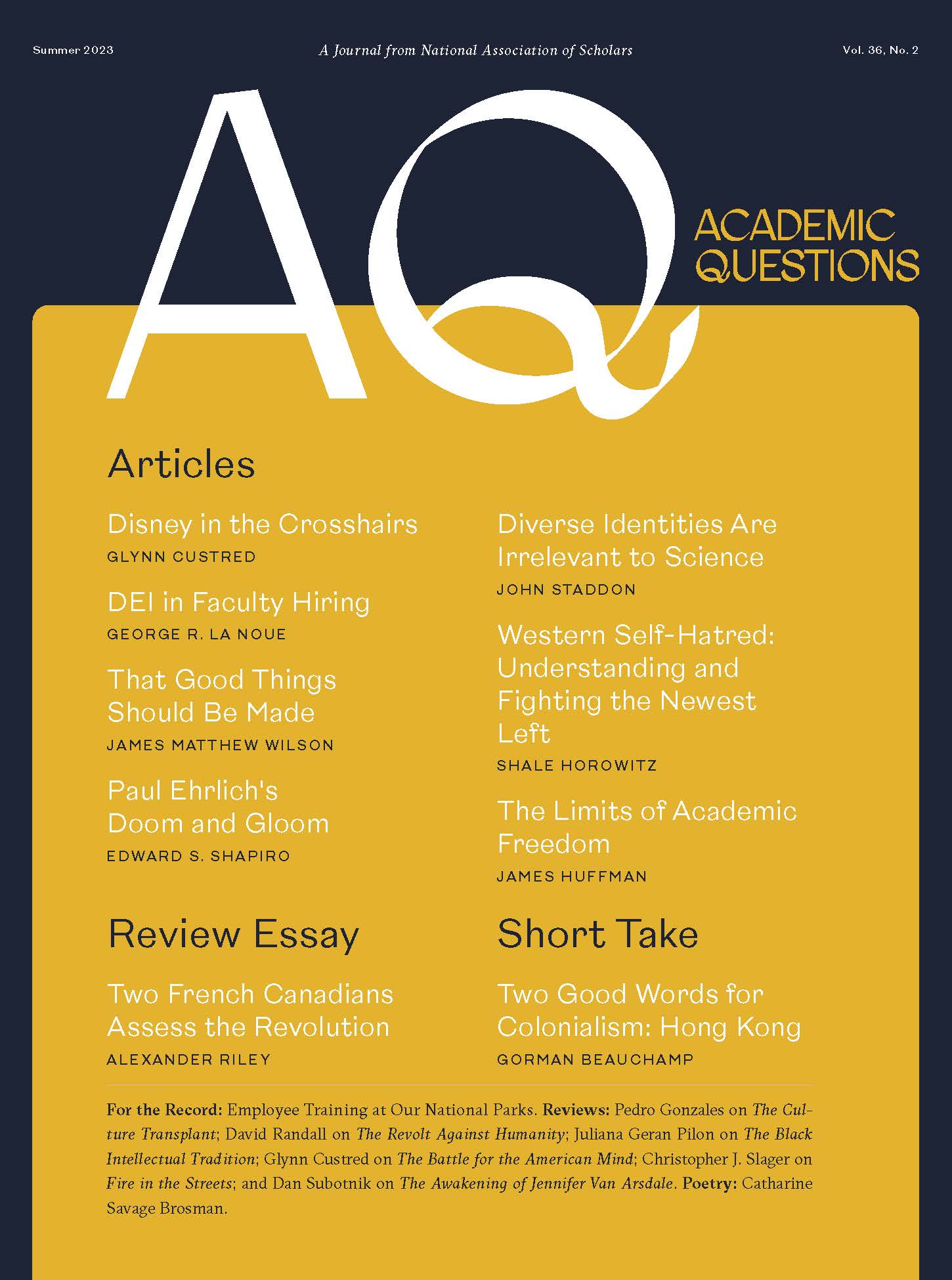The Awakening of Jennifer Van Arsdale: A Political Fable for Our Time, George Leef, Post Hill Press, 2022, pp. 268, $17.63 softcover.
George Leef, the director of editorial content at the James G. Martin Center for Academic Renewal and a ubiquitous figure in conservative media, has written a novel containing many of the ideas he normally shares through non-fiction writing. This is not an easy transition to make. Coherent plotlines don’t magically appear from complex ordinary life and few writers succeed in propagating fully human characters from the fallow soil of public policy talking points. But with a realistic storyline that focuses on the gradual transformation of the novel’s central character, Leef largely succeeds in delivering an engaging and colorful story possessed of discerning political wisdom.
The plot is simple. Jennifer Van Arsdale, a diligent but honest forty-four year old progressive writing for the Washington Post, is selected by Patricia Farnsworth, a recently retired two-term U.S. president, to write her biography. Farnsworth has not forgotten Van Arsdale’s scrappy investigative article that helped vanquish her first electoral opponent, delivering Farnsworth’s own “October Surprise.”
The novel is a species of Bildungsroman, in which Van Arsdale starts out a deeply indoctrinated leftist encased in a liberal lifestyle inside the beltway bubble, but with enough earnest curiosity to indicate room for growth.
After interviewing the president at her southern California mansion, Van Arsdale walks through a bedraggled Laguna Beach where the journalist is accosted by two thugs, only to be saved by an older black man carrying a gun. Van Arsdale is grateful and intrigued by the black man who, through extended conversation, proceeds to unravel many of her treasured leftist pieties—including that gun ownership is always bad. How this will change Van Arsdale’s biography of the former president provides the dramatic tension in the book.
Van Arsdale is also a lover of classical music, something she deeply admires for its honesty and truth, and something she feels should transcend politics. She hears early on that simply attending a concert will subject her to criticism for “supporting the white male power structure” (18) because the orchestra hires primarily on the basis of skill, not ethnicity. (22) Yet Van Arsdale attends the concert (though she disguises herself while doing so). She is similarly discomfited when a Manichean editor gives her the order to “get the word ‘hate’” into her column so as to “get more attention.” (13)
Van Arsdale’s gnawing doubts become palpable during a private luncheon tutorial she attends at Farnsworth’s home. Van Arsdale is a big fan of the former president, believing she had in fact saved the country in her terms as President. But Farnsworth reveals a nefarious and ruthless side unknown to Van Arsdale. She explains that her mentor at Dartmouth College taught her that “either you were for the transformation of America, or you were an ally of the capitalist ruling elite.” (43) Farnsworth’s absorption of this credo led her to an escalating confrontation with a conservative Peruvian fellow student whose career she ultimately ruined. “Maybe he went back to Peru to raise llamas,” Farnsworth chortles. (45) Farnsworth crows about how Democrats in several key states had put in “boxes of reserve ballots . . . to be counted,” (54) and about packing the Supreme Court with six new Justices who eviscerated the second amendment. She argues that because of the continuing effects of slavery, “the notion that people should use logic to decide right from wrong [is] just a tool to privilege the power structure,” (46) and that “white people [have] no standing to appropriate the writings of Black people.” (48)
While Farnsworth concedes that she was defeated in her efforts to suppress “The Star Spangled Banner” with all that “[triggering] stuff about freedom and bravery,” (68) she rounds out her lecture by boasting of her push for mandatory training for federal workers on pronoun misuse. (81)
This disquisition leaves Van Arsdale dazed and confused for her walk on the Laguna Beach Road to Damascus, where Willis Collier saves her from the two thugs and helps crystallize her growing dissonance with the leftist worldview.
In short order Collier establishes himself as a Virgilian guide, providing Van Arsdale with a counternarrative to Farnsworth’s life story. From his own education and experience, he draws a clear set of historically based conservative principles. He attributes a thirty-year decline in California’s fortunes to a series of leftist sins and mistakes. These include regulations that worked to close down businesses, use of eminent domain to transfer property from the middle-class to well-connected people, and licensing rules that keep people from doing work that they want to do.
Collier likewise explains what he sees as the problems in public education: the linkage of education to the goal of self-esteem rather than subject mastery; and the adoption of equity rather than equality rules for enforcing school discipline (“Groups of people don’t act up—individuals do”). Above all, Collier sums up, “Real racism has mostly disappeared, so the people who are invested in racial antagonism have to make up new definitions and imaginary problems to keep people stirred up.” (102)
Collier’s effectiveness as a teacher can be measured by the scope of Van Arsdale’s ideological conversion. But that conversion (“Awakening”) may not be the most important story in the novel. By telling his story through the specific characters he chooses, Leef sheds light on one of the most interesting aspects of contemporary American politics: the rapid change and, in some ways, a reversal of the priorities of the parties on both sides of the ideological divide.
Consider some of the plot’s structural aspects. Collier, a retired electrician and U.S. Navy veteran, is presented as nothing less than saintly. Virtually all the characters who educate Van Arsdale, including Collier and the “Free People of Laguna Beach,” a group formed by Collier’s late wife to provide a sense of community for their dying region, are from groups deemed underprivileged. It is, in other words, the people typically viewed as marginalized that provide the bourgeois WASP Van Arsdale with rational insight and wisdom. By contrast, all of the malefactors, such as Farnsworth and her Dartmouth mentor, are upper-class or high-status elites. This seems almost a quasi-Marxian image in which everything base resides in the upper social echelons and all virtue belongs in the lower ones.
Thus, a picture of contemporary America’s relatively recent political upheaval is made plain. No longer does the progressive left represent the downtrodden and the conservative right the establishment. As the progressive left has marched through the institutions, gaining power and prestige, it is the right that more often seeks change, or at least a restoration, and the left that wants to hold on to power that it has gained.
And why wouldn’t they? Farnsworth’s presidency, which ended only two years prior, was apparently transformative. The newly packed Supreme Court regularly issues “advisory opinions” that preempt legislation. Elections have been federalized and the District of Columbia and Puerto Rico were granted statehood, both of which eased Farnsworth’s way into her second term. Reparations were paid to blacks and universal national health care was implemented. Fossil fuels were eliminated under the auspice of a “Price Stabilization Board.” The censoring power of social media was harnessed by a thoroughly politicized federal bureaucracy. Powerful hate speech laws gave the National Commission to Prevent Hate Speech the tools with which to squash dissent. Ideas and symbols of the past were erased by the Commission on Statues, Names, and Arts. Indeed, Mount Rushmore was blown up!
The novel is dystopic, but Leef’s decision to tell this story through socially unstereotyped characters such as Collier and his cadre of eloquent underdogs gives it a patina of realism. It is easy to imagine real-life Colliers among today’s racial minority groups, which have taken the brunt of destructive leftist policies such as defunding police, porous borders, and cashless bail. Leef’s story, in other words, is not so fantastical that reality can’t be discerned. Leef has managed to draw a portrait of a United States in which the struggling middle-class and conservatives cannot rest easy and in which the ruling class and the left seem disturbingly entitled. Sound familiar?
Dan Subotnik is Professor of Law at the Jacob D. Fuchsberg Law Center at Touro College Central Islip, New York; [email protected]. He is the author of Toxic Diversity: Race, Gender, and Law Talk in America (NYU Press, 2005), among other works. Subotnik’s “Fair or Foul in Interracial Discourse,” appears in our Fall 2021 issue.
Photo by Kevin Nalty on Unsplash













